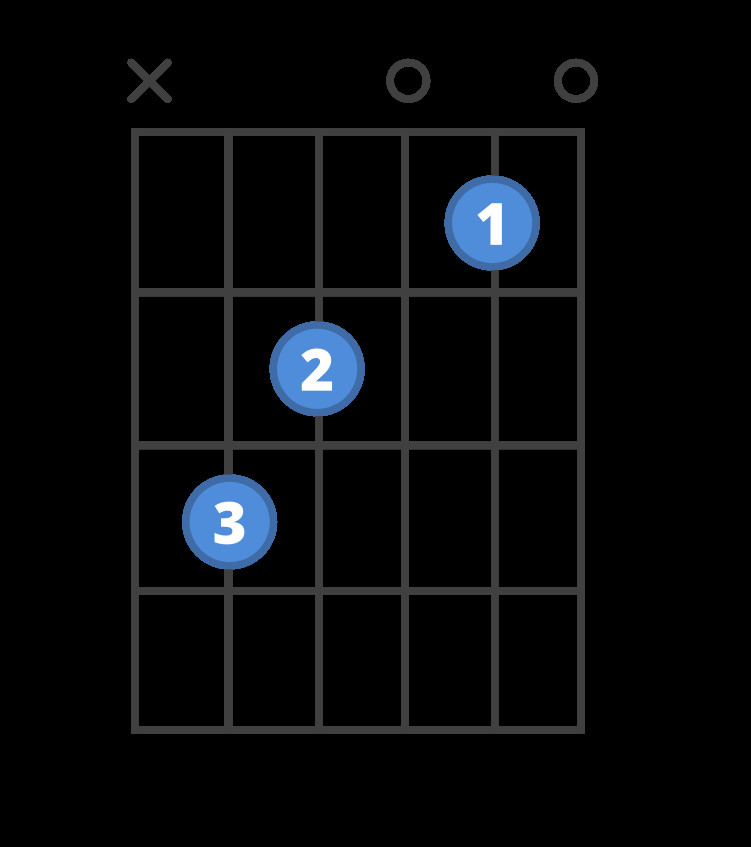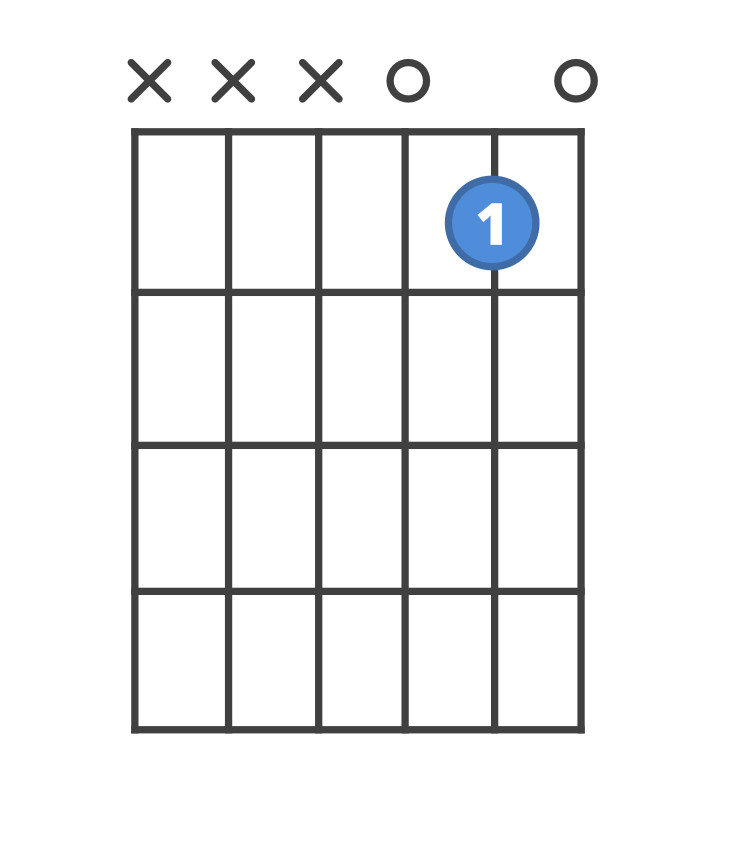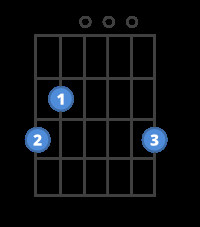Do you want to learn how to play the C chord on the guitar? This comprehensive guide from guitarplayers.net will walk you through the steps, from the most common version to a simplified one-finger option, ensuring that both beginner guitarists and experienced players alike can master this essential chord.
1. What Is The C Major Chord And Why Is It Important?
The C major chord is a foundational chord in guitar playing. It’s a bright, cheerful-sounding chord used in countless songs across various genres. Mastering the C chord unlocks a vast repertoire of music and forms the basis for understanding more complex chord progressions. Learning the C chord is an essential step for any aspiring guitarist.
2. What Is The Most Common Way To Play The C Major Chord?
The most common way to play the C major chord involves using three fingers on specific frets and strings. Here’s a breakdown:
- First Finger: Place your first finger on the 1st fret of the 2nd string (B string).
- Second Finger: Place your second finger on the 2nd fret of the 4th string (D string).
- Third Finger: Place your third finger on the 3rd fret of the 5th string (A string).
- Strum: Strum the thinnest five strings (from the 5th string down to the 1st string). Avoid strumming the thickest string (6th string or low E string).
 Chord diagram for the C guitar chord
Chord diagram for the C guitar chord
Key Tips:
- Finger Placement: Ensure your fingertips are just behind the frets, not directly on top of them.
- Finger Arch: Arch your fingers so that you only press down on the intended strings and don’t accidentally mute adjacent strings. This is crucial for a clean sound.
- Stretch: The third finger placement might require a bit of a stretch, but with practice, it will become easier.
- Strumming: Be mindful not to hit the low E string while strumming.
- Practice: Practice transitioning between the C chord and other basic chords to improve your dexterity and muscle memory.
3. How Can Beginners Simplify Playing The C Chord?
For absolute beginners, the standard C chord can be challenging. A simplified, one-finger version provides an accessible starting point:
- Finger Placement: Place your first finger on the 1st fret of the 2nd string (B string).
- Strum: Strum the thinnest three strings (1st, 2nd, and 3rd strings).
 Chord diagram for the C guitar chord
Chord diagram for the C guitar chord
This version uses the same notes as the full C chord, but it lacks the richness and fullness. Once you’re comfortable with this simplified version, gradually work towards the standard three-finger C chord.
4. What Are Some Common Mistakes To Avoid When Playing The C Chord?
Several common mistakes can hinder your progress when learning the C chord. Recognizing and addressing these issues will significantly improve your playing:
- Muting Strings: Accidentally muting adjacent strings with your fingers is a frequent problem. Ensure your fingers are arched and only pressing down on the intended strings.
- Insufficient Pressure: Not applying enough pressure to the strings can cause buzzing or a weak sound. Press down firmly behind the frets.
- Incorrect Finger Placement: Placing your fingers too far from the fret or directly on top of it can affect the sound. Position your fingertips just behind the fret.
- Strumming All Six Strings: Strumming the low E string (6th string) will result in an incorrect sound. Focus on strumming only the thinnest five strings.
- Rushing The Process: Learning chords takes time and practice. Don’t get discouraged if you don’t get it right away. Be patient and persistent.
5. How Can I Improve My C Chord Transitions?
Smooth chord transitions are essential for fluid guitar playing. Here are some tips to improve your C chord transitions:
- Practice Slowly: Start by practicing the transitions slowly, focusing on accuracy and clean finger movements.
- Anchor Finger: Identify a common finger between the two chords (in this case, C and Am share the same finger) and keep it anchored while moving the other fingers.
- Visualize The Transition: Before making the transition, visualize the finger placement for the next chord.
- Use Chord Flashcards: Use flashcards or apps like ChordBank to practice chord changes in a structured way.
- Practice With Songs: Once you’re comfortable with the transitions, practice them with simple songs that use those chord progressions.
6. What Songs Can I Play Using The C Chord?
The C major chord is used in countless songs across various genres. Here are a few examples perfect for beginner guitarists:
| Song Title | Artist | Genre |
|---|---|---|
| “Hallelujah” | Leonard Cohen | Folk |
| “Let It Be” | The Beatles | Rock |
| “Knockin’ on Heaven’s Door” | Bob Dylan | Rock |
| “Leaving on a Jet Plane” | John Denver | Country |
| “Riptide” | Vance Joy | Indie Pop |
Learning these songs will provide practical application of the C chord and improve your overall guitar playing skills.
7. How Does The C Chord Fit Into Basic Chord Progressions?
The C major chord often appears in common chord progressions, particularly in the keys of C major, G major, and F major. Understanding these progressions will help you grasp the harmonic context of the C chord.
Common Chord Progressions:
- C-G-Am-F: A very common and versatile progression used in countless songs.
- C-F-G: A simple and uplifting progression.
- G-C-D: A classic progression often found in folk and country music.
By learning these progressions, you’ll gain a deeper understanding of how chords work together and be able to play a wider range of songs.
8. What Are Some Exercises To Strengthen My Fingers For Playing The C Chord?
Strengthening your fingers is crucial for playing the C chord comfortably and accurately. Here are some exercises you can incorporate into your practice routine:
- Finger Stretches: Stretch your fingers regularly to improve flexibility and range of motion.
- Finger Independence Exercises: Practice moving each finger independently to develop dexterity and control.
- Chord Repetition: Repeatedly practice forming the C chord, focusing on clean finger placement and smooth transitions.
- Grip Strengtheners: Use grip strengtheners or stress balls to build strength in your hands and fingers.
- Scales And Arpeggios: Playing scales and arpeggios will improve your finger strength and coordination.
Regularly performing these exercises will make playing the C chord, and other chords, much easier.
9. How Can GuitarPlayers.Net Help Me Learn The C Chord And More?
GuitarPlayers.net offers a wealth of resources to help you master the C chord and expand your guitar playing skills. Here’s how:
- Detailed Lessons: Step-by-step lessons with clear instructions and diagrams for the C chord and other essential chords.
- Chord Charts: Comprehensive chord charts with various voicings and fingerings.
- Song Tutorials: Tutorials for popular songs that use the C chord, allowing you to learn in a practical context.
- Beginner Courses: Structured courses designed for beginners, covering essential techniques and concepts.
- Community Forum: A vibrant community forum where you can connect with other guitarists, ask questions, and share your progress.
- Expert Advice: Articles and advice from experienced guitar instructors and professional musicians.
- Address: 1140 Boylston Street, Boston, MA 02215, United States
- Phone: +1 (617) 747-2261
- Website: guitarplayers.net
GuitarPlayers.net provides a supportive and comprehensive learning environment for guitarists of all levels.
10. What Are Some Advanced Techniques That Incorporate The C Chord?
Once you’ve mastered the basic C chord, you can explore more advanced techniques to add flavor and complexity to your playing:
- Alternate Voicings: Experiment with different voicings of the C chord to create different sounds and textures.
- Chord Inversions: Learn how to play C chord inversions to create smoother bass lines and melodic movement.
- Adding Sus Chords: Incorporate Csus2 and Csus4 chords to add tension and release to your progressions.
- Adding Seventh Chords: Use Cmaj7 and C7 chords to create a richer, more sophisticated sound.
- Fingerpicking Patterns: Apply various fingerpicking patterns to the C chord to create beautiful and intricate arrangements.
Exploring these techniques will expand your musical vocabulary and allow you to create more interesting and dynamic guitar parts.
11. Why Is Proper Guitar Maintenance Important For Playing The C Chord?
Proper guitar maintenance is crucial for ensuring that your guitar plays and sounds its best, which directly impacts your ability to play the C chord (and other chords) accurately and comfortably. Here’s why:
- Intonation: Proper intonation ensures that the notes on the fretboard are in tune. If your guitar’s intonation is off, the C chord will sound out of tune, even if you’re playing it correctly.
- Action: The action refers to the height of the strings above the fretboard. If the action is too high, it will be difficult to press down on the strings and form the C chord cleanly.
- String Condition: Old or worn-out strings can sound dull and lifeless, making it harder to achieve a clear and resonant C chord.
- Neck Relief: The neck relief refers to the curvature of the guitar neck. If the neck relief is incorrect, it can cause buzzing or difficulty playing certain notes and chords.
Regular maintenance, including cleaning, string changes, and adjustments to the intonation, action, and neck relief, will keep your guitar in optimal playing condition.
12. What Are Some Common Chord Variations Of The C Chord?
The C major chord has several variations that can add color and interest to your playing. Here are some common examples:
| Chord | Description |
|---|---|
| Cmaj7 | C Major Seventh: Adds a jazzy and sophisticated feel. |
| C7 | C Dominant Seventh: Creates a bluesy and tension-filled sound. |
| Csus2 | C Suspended Second: Has an open and airy quality. |
| Csus4 | C Suspended Fourth: Creates a sense of anticipation and resolution. |
| Cadd9 | C Add Nine: Adds a bright and melodic extension to the chord. |
| C/G | C Major over G: A C major chord with G as the bass note, creating a smooth transition. |
| C/E | C Major over E: A C major chord with E as the bass note, creating a smooth transition. |
Experimenting with these variations will expand your chord vocabulary and allow you to create more interesting and expressive guitar parts.
13. How Can I Use A Capo To Change The Key Of A Song With The C Chord?
A capo is a device that clamps down on the guitar’s fretboard, effectively shortening the length of the strings and raising the pitch of all the notes. You can use a capo to change the key of a song while still using the same chord shapes you already know, including the C chord.
Here’s how it works:
- Determine the desired key: Decide what key you want to play the song in.
- Identify the original key: Determine the original key of the song.
- Calculate the number of semitones: Calculate the number of semitones (half steps) between the original key and the desired key.
- Place the capo: Place the capo on the fret that corresponds to the number of semitones you calculated. For example, if you want to raise the key by two semitones (a whole step), place the capo on the 2nd fret.
- Play the song: Play the song using the same chord shapes you would use in the original key. The capo will transpose the chords to the desired key.
Example:
Let’s say you want to play a song in the key of D major, but you only know how to play it using C major chord shapes. D major is two semitones (a whole step) higher than C major. Therefore, you would place the capo on the 2nd fret and play the song as if it were in C major. The capo will transpose the chords to D major.
Using a capo is a valuable tool for guitarists, allowing you to play songs in different keys without having to learn new chord shapes.
14. What Are The Benefits Of Learning To Play The C Chord On Guitar?
Learning to play the C chord on guitar offers numerous benefits for aspiring and experienced guitarists alike:
- Foundation for Chord Progressions: The C chord is a fundamental building block for countless chord progressions, allowing you to play a wide variety of songs.
- Improved Finger Dexterity: Forming the C chord requires precise finger placement and coordination, which helps to improve your overall finger dexterity.
- Expanded Musical Repertoire: Mastering the C chord opens up a vast repertoire of songs across various genres.
- Understanding of Music Theory: Learning the C chord provides a foundation for understanding basic music theory concepts, such as keys, scales, and chord relationships.
- Creative Expression: The C chord allows you to express yourself creatively through music, whether you’re strumming along to your favorite songs or composing your own melodies.
- Personal Satisfaction: Learning to play the C chord can be a rewarding and fulfilling experience, providing a sense of accomplishment and personal satisfaction.
15. How Can I Stay Motivated While Learning The C Chord?
Staying motivated while learning the C chord, or any new skill, can be challenging. Here are some tips to help you stay on track:
- Set Realistic Goals: Set achievable goals for yourself, such as mastering the C chord within a specific timeframe.
- Practice Regularly: Consistent practice is key to progress. Aim to practice for at least 15-30 minutes each day.
- Find a Practice Buddy: Learning with a friend or fellow guitarist can provide motivation and support.
- Learn Songs You Enjoy: Choose songs that you enjoy listening to and that use the C chord. This will make the learning process more engaging.
- Track Your Progress: Keep track of your progress to see how far you’ve come. This can be a great source of motivation.
- Reward Yourself: Reward yourself for achieving your goals, such as buying a new guitar accessory or attending a concert.
- Join a Guitar Community: Connect with other guitarists online or in person to share your experiences and learn from others.
- Be Patient: Learning guitar takes time and effort. Don’t get discouraged if you don’t see results immediately. Be patient and persistent, and you will eventually achieve your goals.
FAQ: Mastering the C Chord on Guitar
1. Is the C chord hard to learn on guitar?
The C chord can be challenging for beginners due to the finger placement, but with consistent practice, it becomes manageable. The key is to start slowly, focus on accuracy, and gradually increase your speed.
2. What’s the easiest way to play a C chord on guitar?
The easiest way is the one-finger C chord, where you only press down on the 1st fret of the 2nd string and strum the thinnest three strings.
3. What other chords should I learn after C?
After mastering the C chord, learn G, D, Em, and Am. These chords, combined with C, form the basis for countless songs and chord progressions.
4. Why does my C chord sound muffled?
A muffled C chord usually indicates that you’re accidentally muting strings. Ensure your fingers are arched and only pressing down on the intended strings. Also, check your finger placement and make sure you’re pressing down firmly behind the frets.
5. How do I transition smoothly from G to C?
Practice the G to C transition slowly, focusing on keeping your first finger anchored on the 2nd fret of the A string. Visualize the finger placement for the C chord before making the transition.
6. What is the C major scale?
The C major scale consists of the notes C-D-E-F-G-A-B-C. Understanding the C major scale helps you improvise melodies and understand the relationship between the C chord and other notes.
7. How do I use the C chord in a song?
The C chord can be used in various chord progressions, such as C-G-Am-F or C-F-G. Experiment with different progressions and strumming patterns to create your own songs or arrangements.
8. What are some popular songs that use the C chord?
Many popular songs use the C chord, including “Hallelujah” by Leonard Cohen, “Let It Be” by The Beatles, and “Knockin’ on Heaven’s Door” by Bob Dylan.
9. How do I make my C chord sound better?
To improve the sound of your C chord, focus on clean finger placement, proper finger arch, and consistent strumming. Experiment with different strumming patterns and dynamics to add expression to your playing.
10. Where can I find more resources for learning guitar?
GuitarPlayers.net offers a wealth of resources for learning guitar, including detailed lessons, chord charts, song tutorials, and a community forum. Explore the website to find the resources that best suit your learning style.
Conclusion
Mastering the C chord is a crucial step in your guitar journey. With dedication, practice, and the resources available at guitarplayers.net, you’ll be strumming your favorite songs in no time. Remember to focus on proper technique, be patient with yourself, and most importantly, have fun along the way. Visit guitarplayers.net today to explore a world of guitar knowledge, connect with fellow musicians, and unlock your full potential.
 Chord diagram for the G guitar chord
Chord diagram for the G guitar chord
Are you ready to take your guitar playing to the next level? Visit guitarplayers.net now and discover:
- Free guitar lessons for all levels: From beginner basics to advanced techniques, we have something for everyone.
- Comprehensive chord and scale charts: Expand your musical vocabulary and unlock new possibilities.
- In-depth gear reviews: Find the perfect guitar, amp, and accessories to match your style and budget.
- A thriving community of guitar players: Connect with fellow musicians, share your progress, and get inspired.
- Address: 1140 Boylston Street, Boston, MA 02215, United States
- Phone: +1 (617) 747-2261
- Website: guitarplayers.net
Don’t wait, start your musical journey today!

